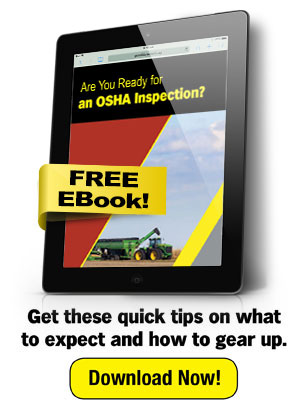This is the final part of a 3 part series on OSHA inspections. If you have not read the previous parts, go back and do that:
Click here for Part 1 - Why would OSHA pay me a visit? and click here for Part 2 - What to do when they show up?.
Can you pass these 5 commonly cited areas with your operation?
On my last post; OSHA Inspection – What to do when they show up (part 2) we covered things to know prior to an OSHA inspection. In this blog I want to address what OSHA might be looking for when they arrive for an inspection.

1. Hazard Communication Program: 1910.1200
Hazard Communication or HAZCOM is frequently cited on ag operations. In fact, it might be the litmus test for your whole operation. If you don’t have a program, don’t have a binder with Safety Data Sheets and employees haven’t been trained, it may indicate to an OSHA inspector to dig deeper in other areas as well.
If you don’t have a written plan you can find several by googling agricultural hazard communication plans. There are several templates to choose from. This OSHA link can provide you with more information; OHSA HAZCOM 1994 Program Guidance. In addition, you can also referance this OSHA link for Hazard Communication Frequently Asked Questions in the process. Here is an example plan tempale. You can also go to the OSHA website to research the most frequently cited violations for your specific industry by using the NAICS number.
Train your employees on how to read and interpret Labels and Safety Data Sheets (SDS) sheets and what protective measures they need to take under the plan. Make sure you have your training documented with date, instructor and attendees (printed name and signature). If OSHA would happen to interview an employee on hazard communication, they might simply answer no to the question(s) asked for various reasons. Being able to document the training can be very valuable to you and the inspector.
2. Machine Guarding: 1928.57
When evaluating machine guarding, OSHA may want to look at PTOs, other power transmission devices such as guarding around belts, shafts and chains in particular and other pinch points. Those may be the low hanging fruit. Training will be a focal point since it is required at the time of initial assignment and annually thereafter. Farm equipment should be outfitted with ROPS and seatbelts. They may want to verify that no additional employees should ever be permitted to ride on farm equipment.
3. LOTO Procedures 1910.147 Control of Hazardous Energy (5a1)
Do you have written LOTO procedures? Have you trained your employees when and how to perform LOTO? Do you provide individual employee protection or locks? How do you handle authorized lock removal? Are you auditing your processes on an annual basis? If you can not answer these questions you should take action to protect your organization.
4. PPE – Personal Protective Equipment (5a1)
This will be covered under the General Duty Clause. Have you made a hazard assessment to determine what PPE is required? Have you provided training for each type of PPE? This draws OSHA’s attention due the high injury counts in agriculture to eyes/face, head, foot, hand, respiratory and hearing. OSHS will review your last 3 years of 301 reports to see the type and frequency of your injuries.
5. Permit Required Confined Spaces (5a1) (1910.146 – confined space regulation or 1910.272 - grain handling operations)
When grain handling operations are involved, OSHA may look to see if you’ve identified all the confined spaces and what you’ve done to prohibit unauthorized entry. Do you have a written confined space program with written procedures? Are your employees trained in confined space procedures? Do you conduct an annual audit? Confined space fatalities draw a lot of media attention such as grain bins and manure storage facilities. You could expect OSHA to inquire about confined space during an inspection.
You may find this YouTube video session taped by Farm Credit East for New York dairy farmers very interesting. The two guest speakers were experts in the area of safety from Wisconsin, including an attorney with an extensive experience defending employers with OSHA citations.
Summary
These 5 areas should not be a surprise when considering where the highest rates of injuries and fatalities occur in agriculture. Understanding what OSHA is likely to look for if they come for a surprised inspection can help you prioritize the part of your program that needs the most attention. In all cases, having a written plan and being able document a training program is vital to a surprize OSHA inspection. Employers have a responsibilty to provide a safe workplace, free from serious recognized hazards, provide tools safe tools and equipment, while complying with standards, rules and regualtions issured under the OSH Act.



